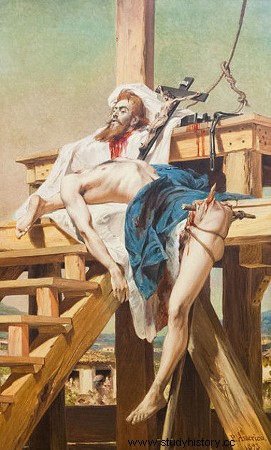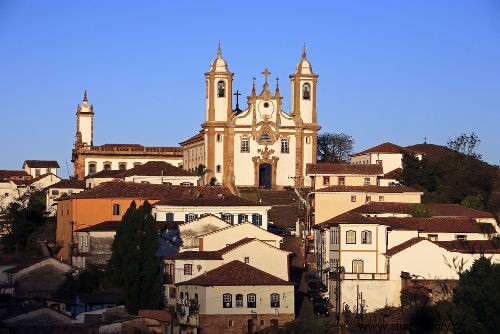
-
Who was Tiradentes?
-
The fifth , a pours
-
Confidentiality
-
Prison, Death and Heroification
“Straps” was the nickname given to Joaquim José da Silva Xavier, who became famous for being one of the leaders of Min Confidence and for having been the only one, among the conspirators, to receive the capital punishment, that is, the death penalty, by hanging.
Born on November 12, 1746, in the then Captaincy of Minas Gerais, during Colonial Brazil, Joaquim José held several professions. Among them was the amateur dentist, which is why he was nicknamed Tiradentes. In addition to being a dentist, Tiradentes also tried his luck as a tropeiro (driver of troops of animals, transporters of goods), miner and peddler (walking merchant), but he failed in all of them. The only profession that gave him stability was the post of ensign – rank below lieutenant – of Royal Dragons of Mines cavalry , the military force acting in the Captaincy of Minas Geras and subordinated to the Portuguese Crown
Tiradentes, despite not being an intellectual, was interested in political writings, such as the constitutional laws of the United States, a country that had gained its independence in 1776, when the ensign had 30 years old. The political interests of Joaquim José da Silva Xavier gradually diverged from the interests of other inhabitants of Vila Rica , which was the center of mining activity in Brazil at the time. Intellectuals like Cláudio Manuel da Costa and Tomás Antônio Gonzaga , both poets and connoisseurs of the philosophical ideas of theFrench Enlightenment , were some of the important personalities with whom Tiradentes joined with the objective of removing from power the then Governor of the Captaincy of Minas Gerais, appointed by the Portuguese Crown, Viscount of Barbacena . But what was the reason for such a revolt?
The main reason that encouraged Tiradentes and others involved in the Inconfidência to rise up against the government of Visconde de Barbacena and the Portuguese Empire was the constant withdrawal of wealth from the region through taxes excessive. From the gold produced in the Captaincy of Minas de Gerais, the Portuguese Crown charged the so-called fifth , that is, the equivalent of about 20% of the total extracted. It so happened that, from the 1760s, the extraction of gold regressed considerably, but not the value of the tax. The rate of the fifth continued to be required of local miners, and Governor Barbacena, to enforce the law, even imposed physical aggression.

City of Ouro Preto, former Vila Rica, where the plot of the Inconfidência Mineira took place
The problem became even worse when, to reverse the lagged margin of the fifths collected, the Portuguese Crown authorized the implementation of the so-called spill
The conspiracy of the inconfidentes began to be prepared in 1788 so that the actions began to be carried out in the following year. Tiradentes, due to his agitated personality, became known as the most radical of the inconfidentes, as researcher Lucas Figueiredo says in his book Boa Ventura! The Gold Rush in Brazil (1697-1810) :
“A radical among moderates, an outspoken among the disingenuous, he advocated – publicly and everywhere (from brothels to the residences of wealthy merchants) – a revolution that would make Minas Gerais independent from Portugal. ''It was a pity'', said the ensign, ''that countries as rich as these [Minas Gerais] were reduced to the greatest misery, just because Europe, like a sponge, was sucking all the substance from them'' ”. [1]
Tiradentes even plotted the death of Visconde de Barbacena, and this was not carried out because Barbacena, through the confession of one of the conspirators, José Silvério dos Reis , dismantled the plot and arrested everyone involved.
Inmates, many of the inconfidentes, fearing severe punishment, did not confess their crimes. The only one to do so was Tiradentes, who, for that very reason, received the harshest penalty, in a process that took place in the city of Rio de Janeiro, which only ended on April 21, 1792 . Tiradentes was “hanged, decapitated and quartered. So that the subjects of the Crown would never forget the lesson, Tiradentes' head was impaled and exposed in a public square in Vila Rica, and his limbs scattered along the road that led to Rio de Janeiro. ” [2]
It is worth noting that, both in the imperial and republican periods, Tiradentes' image came to be taken as an icon of freedom and independence in Brazil, as a hero of the nation . This image was constantly reinforced by paintings (such as the image at the beginning of this text , authored by Pedro Americo ) and monuments (such as the installation of the first monument dedicated to him in the city of Ouro Preto, in 1867). In 1965, already in the first phase of the Military Regime in Brazil, the marshal Castelo White , then President of the Republic, contributed to the reinforcement of this image of Tiradentes, sanctioning the Law Nº 4. 897 , of December 9, which established April 21 as a national holiday and Tiradentes as, officially, Patron of the Brazilian Nation .
NOTES
[1] FIGUEIREDO, Lucas. Good luck! The gold rush in Brazil (1697-1810). Rio de Janeiro:Record, 2011. p. 295.
[2] Idem. P. 297.
By me. Claudio Fernandes
Take the opportunity to check out our video lesson related to the subject:
